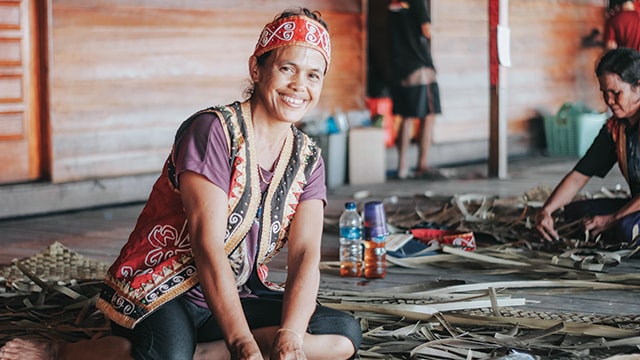Jakarta (Greeners) – The Paris Agreement dictates Indonesia to meet the target of reducing carbon gas emissions by 29 percent. The involvement of all parties is essential in meeting this target. On the other hand, indigenous peoples feel that the government overlooks their efforts to meet emission reduction targets. To the government’s eyes, indigenous peoples’ struggles, especially women from indigenous peoples, are non-existent. Indigenous women have the potential to solve problems rooted in carbon—namely, the issue of access and recognition of the rights of indigenous peoples.
That is the view of the Chairperson of the National Indigenous Peoples Association (AMAN), Devi Anggraeni. She voices her thought in a webinar Potensi Nilai Ekonomi Karbon dan Implementaasinya di Indonesia, Wednesday (21/10/2020). Anggraeni emphasizes that there will be no reduction in emissions from deforestation and forest degradation without recognition of indigenous peoples’ rights. No right, no reed.
Indigenous Women Have Significant Role in Indigenous Communities
Furthermore, in forestry conflicts, indigenous women are among the most vulnerable groups. It is although indigenous women are the key actors in reducing emissions. Anggraeni says, in everyday life, women hold the primary function in regulating indigenous communities’ survival.
“However, the perspective of indigenous women’s importance over land management in their customary territories is seldom heard of—both inside and outside the indigenous community itself,” Anggraeni protests.
Anggraeni testifies that indigenous peoples, especially indigenous women, have carried out the process of suppressing carbon emissions at a concrete level. She gives an example of indigenous women’s involvement in rehabilitating the former coal mining area in East Barito, Central Kalimantan. To do the reforestation, indigenous women grow used plants and plants for woven materials.
Further, Anggraeni urges the government to attend for indigenous peoples. The government’s presence is significant, especially in strengthening indigenous peoples’ capacity and financial assistance to reduce carbon emissions. Significantly, she continues, regarding the recognition and protection of the rights of indigenous peoples.
“If there is no protection of rights, it will be difficult to accept the (emission reduction) process. It will also be related to the recognition of customary territories. Give space to acknowledge indigenous peoples and indigenous women in their capability to develop nature management and customary territories,” says Anggraeni.
Also read: Farmers Empowerment Committee: The State Has a Large Debt to Indonesian Farmers
Carbon Economic Value to Reduce Emission
Other than addressing indigenous peoples’ role in emission reduction, the same event also discussed the Carbon Economic Value (NEK). NEK is a cost that must be paid for the existence of greenhouse gas (GHG) emissions. At the same time, Assistant Special Envoy for the President for Climate Change Control (UKP-PPI) 2010-2019, Kuki Soejachmoen, explains that NEK could be one way for Indonesia to reach its Nationally Determined Contribution (NDC) commitment.
Soejachmoen argues that one of NEK’s applications is to apply a carbon tax by providing a specific price for GHG emissions according to the emissions produced.
The higher the emissions, the more expensive the payment,” Soejachmoen clarifies.
In its application, Soejachmoen continues, NEK utilizes the carbon market, which is used to facilitate transactions and transfers of GHG emission reduction. This carbon market consists of the international carbon market and the domestic carbon market. These two markets, he continues, can use both mandatory and voluntary transaction types. Thus, Indonesia can take advantage of the international carbon market but still prioritizes the domestic or national carbon market to achieve Indonesia’s NDC.
Soejachmoen pursues to mention requirements for the domestic market. The domestic carbon market requirements include setting national GHG emission limits, the stipulation of regulated sectors and emissions, emission permit allocation; flexibility in compliance; institutional behavior; utilization of government revenue from domestic carbon markets; and providing incentives for voluntary market players who will become suppliers of offsets.
“NEK and its instruments for the domestic market need and are important to be implemented to help achieve Indonesia’s NDC,” he concludes.
Reporter: Muhammad Ma’rup
Editor: Ixora Devi



















































